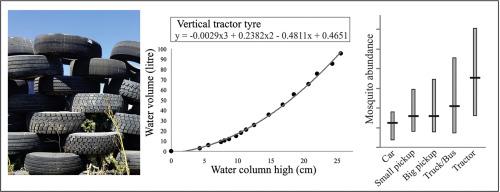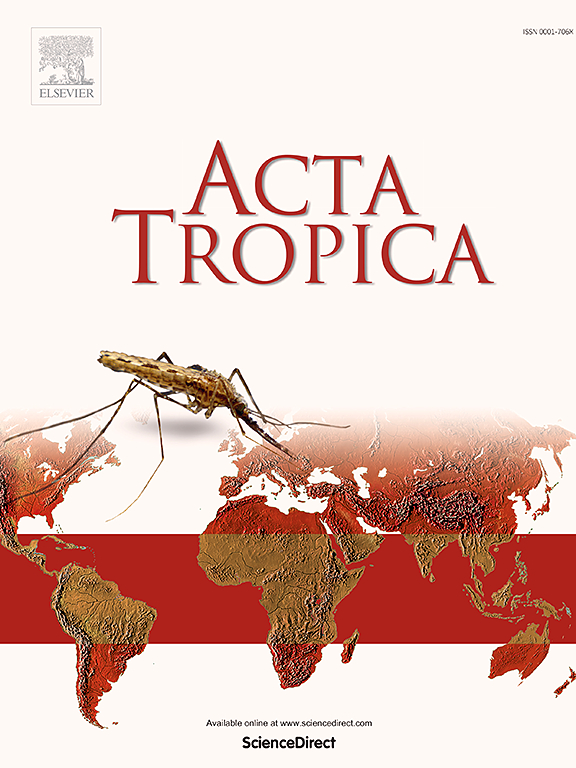估算废弃轮胎中未成熟蚊子总丰度的方法建议:以埃及伊蚊和喙库蚊为研究案例。
IF 2.1
3区 医学
Q2 PARASITOLOGY
引用次数: 0
摘要
由于蚊子的形状和大小,估算废弃注水轮胎中未成熟蚊子的数量是一项费力的工作。我们的目标是开发一种程序,通过对水样中的个体进行计数,来估算它们的总数量。我们针对五种轮胎类别(从汽车到拖拉机)和水平/垂直储存位置,拟合了连接水柱高度和水量的多项式函数。然后,采用这种方法对阿根廷温带地区 16 个轮胎堆中的 358 个废弃充水轮胎进行了调查。垂直位置的轮胎容量大于水平位置,拖拉机轮胎的最大容量为 95.6 升。相比之下,田间条件下的留水量则显示出相反的模式,水平位置的轮胎留水量更大。在不同的轮胎类别中,水平轮胎的留水量都有明显增加(J-T=7306,p<0.05)。本文章由计算机程序翻译,如有差异,请以英文原文为准。

A methodological proposal to estimate the total abundance of immature mosquitoes in discarded tyres: Aedes aegypti and Culex pipiens as study cases
Estimating the abundance of immature mosquitoes in discarded water-filled tyres is a laborious task due to their shape and size. Our objective was to develop a procedure that allows, by counting individuals in a water sample, to estimate their total abundance. Polynomial functions linking water column height and water volume were fitted for five tyre categories (from cars to tractors) and horizontal/vertical storage positions. A total of 358 discarded water-filled tyres were then surveyed using this method in 16 piles of tyres in temperate Argentina. Tyre capacity was greater in vertical than horizontal position, reaching a maximum of 95.6 L in tractor tyres. In contrast, the volume of water retained under field conditions showed the opposite pattern, being greater in horizontal tyres. Water volume increased significantly across tyre categories in both horizontal (J-T = 7306, p < 0.001) and vertical (J-T = 10,792, p < 0.001) positions. Most infested tyres (n = 150) showed low abundances and a few extremely high values, both for all mosquito species grouped and for Culex pipiens and Aedes aegypti separately. The median abundance of mosquitoes per infested tyre was 35, decreasing to 30 for Cx. pipiens and 17 for Ae. aegypti. These values increased significantly across tyre categories for mosquitoes (J-T = 5525, p < 0.001) and Cx. pipiens (J-T = 2275, p < 0.05), but not for Ae. aegypti (J-T = 1526, p = 0.472). The comparison between vertical and horizontal positions was not significant for both vector species. Our methodological approach could be particularly useful in research addressing the assessment of disease risk associated with mosquito productivity.
求助全文
通过发布文献求助,成功后即可免费获取论文全文。
去求助
来源期刊

Acta tropica
医学-寄生虫学
CiteScore
5.40
自引率
11.10%
发文量
383
审稿时长
37 days
期刊介绍:
Acta Tropica, is an international journal on infectious diseases that covers public health sciences and biomedical research with particular emphasis on topics relevant to human and animal health in the tropics and the subtropics.
 求助内容:
求助内容: 应助结果提醒方式:
应助结果提醒方式:


